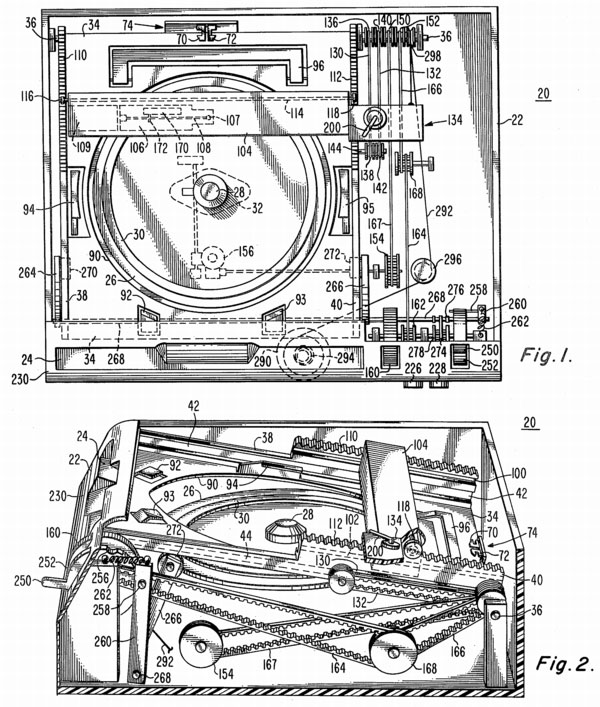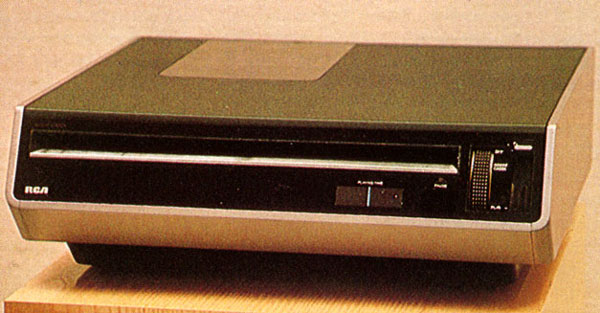
 |
Search | FAQ | US Titles | UK Titles | Memories | VaporWare | Digest | |||||||
| GuestBook | Classified | Chat | Products | Featured | Technical | Museum | ||||||||
| Downloads | Production | Fanfares | Music | Misc | Related | Contact | ||||||||
| Featured CED Patent No. 4,227,699 | ||||||||||||||

The prototype player described in the patent is outwardly similar to the final production model, but was substantially different internally. As seen in the photograph below the player is the same size as the production SFT100, and is much smaller than the prior generation prototype. In this late 1978 time frame RCA had also decided on carbon-doped discs housed in caddies.

The familiar function lever can be seen at the right front of the player, but immediately to its right is a control absent from the production players, and absent from this particular prototype are the search buttons present in the production models. With all the design changes, I believe a list covering each one in detail is appropriate:
Thumbwheel Control: That control to the left of the function lever and No. 160 in the patent figures is a thumbwheel that can be rotated up or down to visually search the disc forward and backward at variable speeds, thus also providing repeat play. It works much the same way as the jog control on many modern video appliances, and this prototype may be the first instance of one of these being used. This thumbwheel was replaced by the front-panel search buttons on the production players, but the prototype still has a pause button on the front panel that controls an electromagnetic stylus lifting/lowering mechanism.
Indicia Time Indicator: A couple inches to the left of the thumbwheel and No. 290 in the patent diagram is a playing time indicator. This is designed the same way as the radio dial indicators in old-style audio receivers and car radios. A cord (292) extends between the carriage (104) and the indicia bearing dial such that the displacement of the carriage along the guiding rail effects synchronized rotation of the dial as the disc plays. A torsion spring (294) is tensioned by the carriage during disc play. During caddy insertion this tension aids in returning the carriage to the starting position. This analog time indication is similar in concept to that used in the production Hitachi players, but is more complex in design due to the unique tensioning mechanism. All the production RCA players that had time indicators used a two-digit LED indicator representing elapsed minutes of playback.
Inclined Caddy Guiding Groove: As shown by Nos. 42 & 44 in Fig. 2, the caddy is inserted at a slight downward angle rather than straight in, which was characteristic of the production F/G players. In this prototype model the turntable was fixed in position, so after insertion the disc platform was lowered onto the turntable for playback. This is very similar to the way all Hitachi players from the initial VIP1000 onward operated, as Hitachi was able to examine RCA prototypes during this time. Oddly enough, RCA abandoned the concept of a fixed turntable for the production SFT100, instead having the disc fixed in place after insertion and the turntable rising to meet it. With the later J/K models RCA returned to the concept of a fixed turntable.
Centered Spine Latching Mechanism: Nos. 70 & 72 in the patent figures show that the mechanism to latch the caddy spine is located at the center of the spine, and inserts itself into a rectangular opening on the spine. In the production system the entire length of the spine is grooved top and bottom, and the latching mechanism simultaneously grabs the spine at both ends.
Patent No. 4227699 was issued to Leslie Torrington, a mechanical engineer who originally joined RCA as a record-changer designer. Later he worked on RCA's MagTape system before joining the VideoDisc project in 1973. There he received a number of patents relating to mechanical design, particularly for the disc caddy system. On November 3, 1981 he was awarded a Technical Excellence Award for his work on VideoDisc.